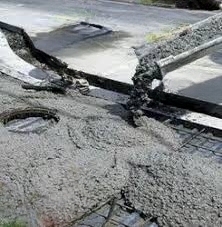Table of Contents
What is Concrete?
Concrete is a mixture of water, cement, and aggregate. Cement works as a binding agent. Cement mix with water and aggregate to make concrete. Water and cement are used in different ratios as per requirement. If the water-cement ratio is low then concrete will be stronger and vice-versa.

To increase the workability of concrete and reduce the water-cement ratio, admixtures are mixed in the concrete.
What is the Grade of Concrete?
The grade of concrete indicates the strength of concrete.
Example: M30 concrete grade.
Here, M represents Mix, and 30 represents 30 Mega Pascal or 30 MPA which is the strength of concrete.
Different Grades of Concrete:
The grade of concrete is expressed by mix proportion. Like M25 grade of concrete has 1 ratio cement, 1 ratio sand, and 2 ratio aggregate. It will be represented as 1:1:2.
Different grades of concrete which are normally used in construction are as follows.
| Concrete Grade | Mix Ratio (cement: sand: aggregate) |
|---|---|
| M10 | 1:3:6 |
| M15 | 1:2:4 |
| M20 | 1:1.5:3 |
| M25 | 1:1:2 |
| M30 | 1:0.75:1.5 |
| M35 | 1:0.5:1 |
| M40 | 1:0.25:0.5 |
Types of Concrete
- Plain Concrete
- Reinforcement Concrete
1. Plain Concrete:
When concrete is poured without using any reinforcement called plain concrete. Plain concrete is used when structural members are subjected to compressive load only and there should be no tensile load.
2. Reinforcement Cement Concrete (RCC):
Reinforcement Concrete is used to resist both compressive and tensile load. It is used for casting of the beam, column, slab, foundation, shear wall, retaining wall, etc. Reinforcement Concrete is used to resist bending which is occurred due to tensile load.
Concrete Construction Procedure:
It is very important to know the procedure of concrete work to get the desired result. Concrete construction procedures are as follows.
- Mixing of material with water.
- Workability test with help of slump test.
- Transportation of concrete to the construction site.
- Pouring of concrete.
- Vibrating for good compaction.
- Formwork removal work after a suitable time.
- Application of curing member as per site requirement.
Conclusion:
In this blog post, you have read about what is concrete? grades of concrete, types of concrete, and construction procedure of concrete.
FAQS
What are the primary components of concrete and how are they mixed?
Concrete is a construction material composed of cement, aggregate (such as gravel or crushed stone), and water. These ingredients are mixed together in specific proportions to create the final product.
What are the different types of concrete and their uses?
There are various types of concrete, each with its unique characteristics and uses. Some examples include regular strength concrete, high strength concrete, lightweight concrete, and pre-stressed concrete. Each type has its specific application in construction.
What are the typical uses of concrete in construction?
Concrete is widely used in construction for building foundations, floors, walls, and structures such as bridges and roads, among others.
What is the origin of the term “concrete”?
The name “concrete” is derived from the Latin word “concretus,” meaning compact or condensed. This refers to the solidified form of the mixture of cement, aggregate, and water.
What is the distinction between cement and concrete?
Cement is a binding ingredient that is one of the components of concrete. Concrete, on the other hand, is the final product created by mixing cement, aggregate and water in specific proportions.
How is the compressive strength of concrete measured?
The grade of concrete refers to its compressive strength, which is the amount of weight it can withstand before breaking. It is typically measured in pounds per square inch (PSI).
Why is concrete considered a more versatile and durable building material than cement?
While cement can be used as a binding ingredient, concrete is more versatile and durable due to the presence of aggregate and water. The combination of these ingredients creates a stronger and more resilient final product.
Is concrete more long-lasting than cement?
Concrete is considered more durable than cement alone because it is a stronger and more resilient construction material, composed of cement, aggregate, and water.
What are the common types of concrete?
The two main types of concrete are regular strength concrete and high strength concrete.
How does the strength of concrete compare to that of cement?
Concrete, made up of cement, aggregate, and water, is stronger than cement alone due to the presence of aggregate and water which increase its strength.
- Dog-Legged Staircase
- Difference Between STAAD Pro and ETAB
- California Bearing Ratio (CBR) Test
- What are Modular Kitchens?
